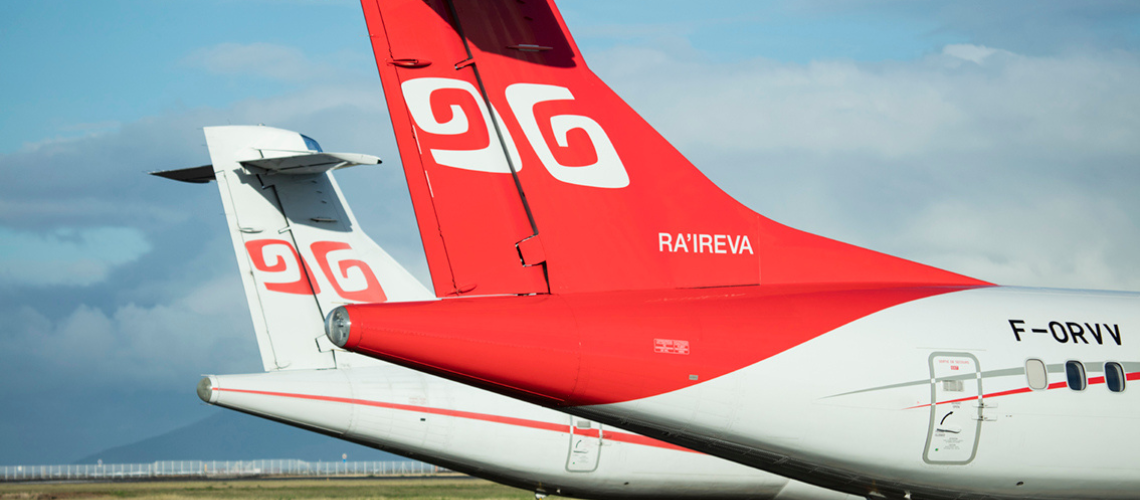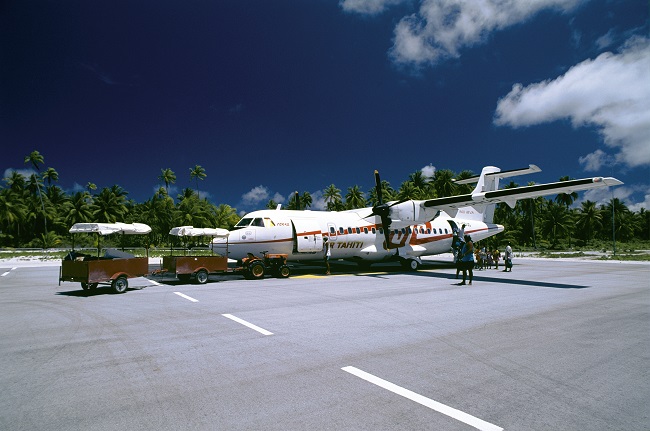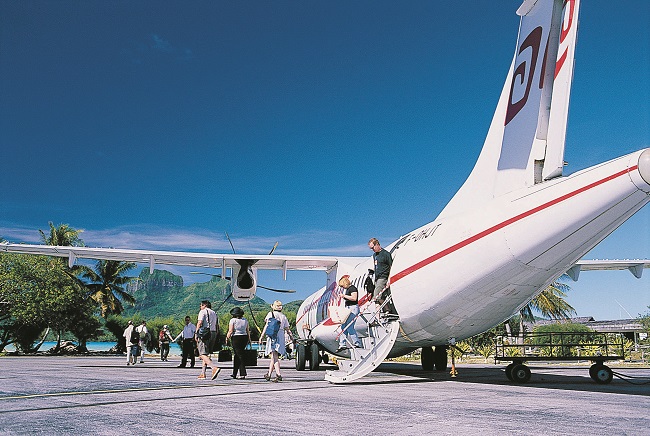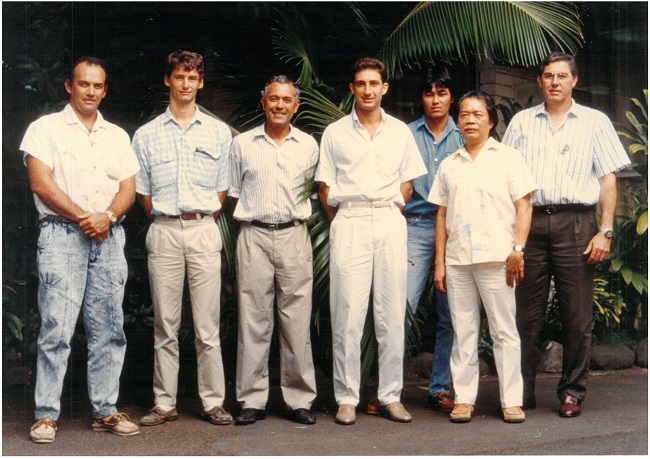 Air Tahiti
Air Tahiti

From Air Polynésie to Air Tahiti
Air Polynésie had experienced an impressive development of the network. Which is what characterizes it best. However, the fleet of Fokker Fairchilds that it used, were certainly good planes, but they were very costly to run. They were extremely fuel inefficient. They were also technologically outdated and therefore costly to maintain. Production costs were so high that the price of plane tickets was extremely expensive, without any price modulation, that is, without the possibility of offering reduced prices for certain types of client. Despite the astronomic price of tickets, Air Polynésie was losing money hand over fist, even whilst receiving subsidies from the Territory’s local authorities, to operate services to the most isolated archipelagos. The Fokker business model was at the end of its rope, on the edge of bankruptcy…
Negotiations regarding the future directions for Polynesian domestic air travel, between the French Polynesian authorities and the French international air company UTA, of which Air Polynésie was a subsidiary, were tense, to say the least. UTA argued for a long-term travel contract in order to be able to invest in a new generation of aircraft, the ATR series as it happens.
The Territory was considering this option, but also had another offer on the table, from a group of Polynesian investors. They proposed to invest in jetplanes, Fokker 28s, secondhand planes, to serve the main islands of French Polynesia. There was therefore a big confrontation between these two quite different technological propositions. The local government needed to choose an appropriate solution in terms of the technology, but there was also a political desire to gain control of this domestic air company, 85% of the company’s capital at that moment was in UTA’s hands.
The choice of jets would be extremely inappropriate, given the specificities of the network in French Polynesia. For examplea Fokker 28, a jet plane, consumed 8 times more fuel than an ATR, a turboprop plane, on a journey from Papeete to Bora Bora!
 The ATRs were the key to the company’s development. Pictured here, an ATR 42 in Manihi © Philippe Bacchet
The ATRs were the key to the company’s development. Pictured here, an ATR 42 in Manihi © Philippe Bacchet
Air Tahiti, the airline of all Polynesians
It has been proposed that UTA relinquish a large part of their share in Air Polynesie: 70 out of their 85 %. To cede a partial stake, of 25% value to the Territory for the token sum of one franc.As for the remaining 45 %, this was purchased by major local economic players: the Bank of Socredo, Bank of Tahiti and Bank of Polynesie, as well as private business groups that "counted" in Tahiti. Everyone got on board!
Air Tahiti became the company of all Polynesians. This was its distinguishing feature, from 1985 up to today, because this situation persisted, the make-up of its stakeholders has remained stable. A fact that is demonstrated by the distribution of its capital, a small minority coming from public institutions, the large majority owned by local private investors.
In 1985, two years before the "official" creation of Air Tahiti, UTA had passed from owning 85 % to 15 % of Air Polynésie’s capital, giving 25 % to the Territory for the token sum of one franc.… Today, the Territory maintains a 14 % share in Air Tahiti, what remains of the 25 % stake initially obtained for a symbolic 1 franc, that is almost nothing…
The business plan presented demonstrated clearly that the big economic and technical advancement was to invest in a new generation of aircraft, the ATRs. This investment would result in economies in maintenance fees and fuel consumption. The running costs would not be very heavy. What is more, buying new aircraft meant that it was possible to benefit from "defiscalization" (editor’s note: this is a French tax relief program that encourages private investment in the overseas territories from metropolitan France, by means reducing tax rates).
Air Tahiti was one of the first in the Territory to benefit from this measure. The potential investors were ready to put their money into it, because they considered Air Tahiti to be a fundamental tool for developing French Polynesia. This vision wasn’t just shared by Polynesian business men, but also by the politicians of the time, on all sides. Air Tahiti was thought to be a strategic company, fundamental for the development of French Polynesia.
 In 2000, an ATR 72 disembarks its passengers in Bora Bora, one of the major destinations in the network © Philippe Bacchet
In 2000, an ATR 72 disembarks its passengers in Bora Bora, one of the major destinations in the network © Philippe Bacchet
The Territorial authorities had bought from Marcel Lejeune the company Air Tahiti, which mainly operated the Tahiti-Moorea route with its small Britten-Norman aircraft. Air Polynésie acquired from the Territory the company Air Tahiti, which became its subsidiary in 1985. Then it eventually took its name. This is how Air Polynésie became Air Tahiti.
In October 1985, the first meeting of the board of directors was held, with a totally new set of faces. Previously, the board had included just two Polynesian directors: Jacques Denis-Drollet and René Quesnot. All the rest were people from UTA. Similarly, all of Air Polynésie’s CEOs were UTA expats. Air Polynésie was not a Polynesian company, in terms of its management and investors. On the other hand, it certainly was Polynesian in terms of its staff, something it deserves credit for.
During its years of activity, Air Polynésie had trained a good number of Polynesian personnel in careers centered around air transport, as well as some executives, but they were not on the company’s board of directors. The executive officers wanted to apply the principle of "oceanization" to management posts, that is to say, they firmly believed that you could find people capable and adept at managing and taking on such responsibilities right here in French Polynesia. Somewhere, that was all logical, within the context of the new statute of political autonomy, that French Polynesia had been granted in 1984. True autonomy is being able to take control of the gear levers and drive the development of the country, using Polynesian talent to undertake the projects.
 The company’s management team at the end of the 1990s (from left to right): Manate Vivish, Yves Wauthy , Mate Galenon, Christian Vernaudon, Patrick Martineau , Auguste Yu, Christian Massonat
The company’s management team at the end of the 1990s (from left to right): Manate Vivish, Yves Wauthy , Mate Galenon, Christian Vernaudon, Patrick Martineau , Auguste Yu, Christian Massonat
Serving the population, economic development, and tourism of the country
The new team decided to change the name of Air Polynesia to Air Tahiti for reasons of international commercial marketing. To tourists worldwide, "Air Polynesia" doesn't mean anything... But the name Air Tahiti carries a different significance. Moreover, 10 years later, when the Territory decided to launch an international airline – the future Air Tahiti Nui – the authorities wanted to take the name Air Tahiti, but we didn't yield. Consequently, they opted for Air Tahiti... Nui (Editor's note: "nui" in Tahitian means large).
In two years, the 4 Fokker Fairchilds were replaced by 4 ATRs. Thus, by 1988, Air Tahiti had a fleet consisting of 4 ATR 42s with a capacity of 48 seats, and the first ATR 72, capable of accommodating 68 passengers, arrived in 1993. The choice of the ATR was therefore a determining factor. This is how Air Tahiti increased frequencies, which was favorable for tourism development, thus providing more flexibility to organize stays on the islands.
Air Tahiti successively purchased the generations of ATR 300, then the 500, and the generation of ATR 600. This is important to have the most efficient and fuel-efficient aircraft. The 600 series is the most fuel-efficient aircraft in its category. Having new aircraft is also a guarantee of reliability, which is of great importance to its network.
With Air Tahiti, air travel has truly become accessible. One of the key elements was the implementation of a policy of differential tariff reduction according to customer types. Air Tahiti made air travel accessible to low-income populations, which was not the case before. The Territory also supported Air Tahiti by enlarging the island runways and bringing them up to "ATR" standards to make them accessible to this cornerstone aircraft of Air Tahiti, thus contributing to the development of activity. Today, air transport is accessible to 99% of the Polynesian population. Very few inhabited islands are not served, which represents a major advancement and a unique feat in terms of territorial development.
Beyond the domestic air transport activity of the parent company Air Tahiti, the Management has implemented a group development policy in related sectors. In November 1988, Air Tahiti acquired the international stopover activities in Tahiti that had remained until then under UTA. It also developed subsidiaries such as Air Archipels.
Furthermore, Air Tahiti was a major player in tourism development in the 1990s and 2000s by initiating, with Banque Socredo, the creation of FHP, the Polynesian Hotel Financing, for hotel construction in archipelagos outside the Society Islands (since transferred to other groups of local investors). The first was the Manihi Pearl Beach in the Tuamotus, then the Bora Bora Pearl Beach. It also created hotels on the atoll of Tikehau in the Tuamotus, on Taha’a in the Leeward Islands, and in the Marquesas, notably on the islands of Hiva Oa and Nuku Hiva. It should also be noted that Air Tahiti was, with the Territory, one of the founding shareholders of Air Tahiti Nui in the late 1990s. Air Tahiti also created travel agency activities for residents of Tahiti and the islands during this time: Moana Holidays, which for a time offered international trips, and finally the local tour operator Séjours dans les îles Air Tahiti, created in 1991-1992, still a major player in the sector.